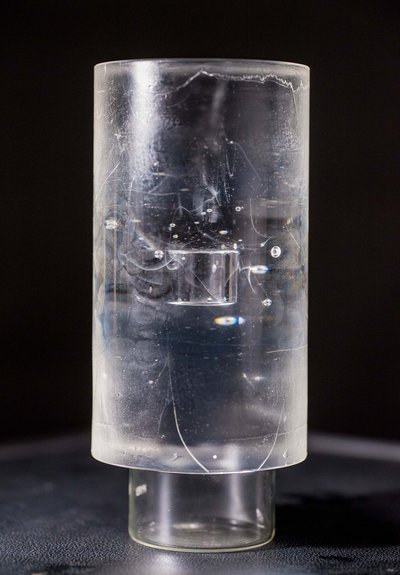Key details
Date
- 29 September 2021
Author
- RCA
Read time
- 3 minutes
Wayne Binitie, an AHRC-funded Royal College of Art (RCA) PhD student, is the artist behind Polar Zero. The immersive exhibition at Glasgow Science Centre injects an artistic and cultural dimension to the climate negotiations at the Conference of the Parties of the UN Framework Convention on Climate Change (COP26).

At a time of accelerating global warming, rapid melting of glaciers and rising sea levels Polar Zero invites us to pause and reflect on humanity’s impact on our past, present and future climate.
The centrepieces of the exhibition are a cylindrical glass sculpture encasing Antarctic air from the year 1765 – the date that scientists say predates the Industrial Revolution – and an Antarctic ice core containing trapped air bubbles that reveal a unique record of our past climate. The exhibition theme is one of hope and optimism.
Polar Zero, a collaboration between British Antarctic Survey (BAS), global engineering and consulting firm Arup and the Royal College of Art (RCA), is funded by the Arts and Humanities Research Council (AHRC).
Wayne Binitie’s work is inspired and informed by the urgent need to address the climate crisis. He says:
'About five or six years ago I formed a unique relationship with BAS and Arup. Our collaboration involves artistic creativity, ice core science and advanced engineering. It’s my hope that people who experience these works will gain a better understanding of humanity’s impact on the natural environment and its climate systems.'
Ice cores are cylinders of ice drilled out of an ice sheet or glacier. They contain information about past temperature, and many other aspects of the environment. Crucially, the ice encloses small bubbles of air that contain a sample of the atmosphere – from these it is possible to measure directly the past concentration of gases (including carbon dioxide and methane) in the atmosphere.
1765 –Antarctic air encases an air sample extracted from an Antarctic ice core and preserved forever within the sculpture. This air connects us with a pivotal moment in the Earth’s history, the dawn of the industrial revolution. BAS ice-core laboratories reveal 1765 as a crucial date after which human activity began to fundamentally accelerate the growth of greenhouse gases in the Earth’s atmosphere.
Over 250 years ago Scottish inventor James Watt improved the steam engine to reduce waste and cut fuel costs. This innovation sparked the Industrial Revolution and a chain reaction that changed the world.

Dr Paul Thompson, Vice-Chancellor of the Royal College of Art, says:
'Wayne Binitie’s time capsule of the Earth’s atmosphere from the year 1765 captures all the magical curiosity of an insect fossilised in amber. A pre-industrial world, frozen in glass, provokes powerful emotions and demands a call to action from delegates at COP26. It has been a real privilege for me, watching Wayne’s research evolve with the support of the AHRC over the past few years.;
BAS Glaciologist Dr Robert Mulvaney says:
'Our ice core research reveals the human impact on our climate. This research collaboration with Wayne will, I hope, encourage people to think about the past, present and future. It has been a journey of discovery for artist, scientist and engineers, involving high levels of creativity that I’ve found very exciting. Exchanging ideas in the ice core lab or over a coffee was stimulating and I hope that people visiting Polar Zero get a sense of that. Antarctic ice is an archive of the Earth’s hidden climate history. The skill of the artist is in helping us tap into human emotion to provoke curiosity, action and hope for the future.'

Arup’s engineering expertise was critical to realising Polar Zero. This is the first time that anyone has attempted to extract ancient air from an ice core and encase it within a glass sculpture. Exhibiting an ice core without it melting completely is a technical feat that requires precise calculations and creative thinking to construct the right level of insulation while still allowing the visitors to get up close to the ice.
Visitors to Polar Zero will experience the sound of ancient air bubbles popping as an Antarctic Peninsula ice core emerges from an insulated tube. As it drips and melts away it captures the fragility of the polar ice. Audio recordings of these ancient gases escaping from ice cores have been incorporated by the artist into a musical soundtrack that evokes the sense of time ticking away, completing this intimate multi-sensory experience.
Fragments from Ice Stories – personal anecdotes, memories and oral testimonies from national and international scientists and experts whose lived experiences of the Arctic and Antarctic – hint at the science that inspires the artworks.
Polar Zero is made possible by funding from the Arts & Humanities Research Council.